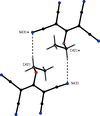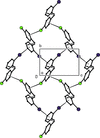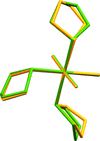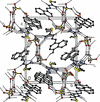issue contents
September 2016 issue

Cover illustration: The compound [Co(C10H15)(C2H4)2] or Cp*Co(CH2CH2)2, where Cp* is pentamethylcyclopentadienyl, is an important precursor for the generation of fragments used in C-H bond activation, cyclotrimerization ofalkynes or in C-S activation. Although all atoms of the molecule are located on general positions, the complex essentially has point group symmetry C2v, in agreement with solution 1H NMR data. The Co-C(olefin) bonds have an average length of 2.022 (2) Å, while the C-C(Cp*) bonds are longer [average 2.103 (19) Å]. See: Ramful, Robertson & Ylijoki [Acta Cryst. (2016). E72, 1301-1304].
research communications
Download citation


Download citation


Two ytterbium(III) complexes comprising alkynylamidinate ligands, Cp2Yb[(iPr2N)2C—C≡C—c-C3H5] (1) and Yb[(CyN)2C—C≡C—Ph]3 (Cy = cyclohexyl) (2) have been synthesized and structurally characterized. Both complexes are monomers without any coordinated solvent in the solid state.
Download citation


Download citation


A distorted octahedral NS5 donor set is found in the binuclear title molecule which features an unprecedented [Cd(dithiocarbamate)2]2 core. Molecules are connected into a three-dimensional architecture by O—H⋯O,N hydrogen bonding.
CCDC reference: 1496352
Download citation


Download citation


Crystal structure of 1-amino-2-oxo-2,5,6,7,8,9-hexahydro-1H-cyclohepta[b]pyridine-3-carbonitrile
In the title compound the seven-membered ring adopts a conformation such that the three atoms not involved in the aromatic plane lie on the same side of that plane. One hydrazinic H atom forms an intramolecular hydrogen bond to the O atom; the other forms a classical intermolecular hydrogen bond N—H⋯O, which combines with a `weak' Har⋯O interaction to build up double layers of molecules parallel to the bc plane.
CCDC reference: 1496294
Download citation


Download citation


The packing of the title compound is built up by columns of π–π stacking quinoline derivatives running along the c axis, which are interconnected by [Ni(H2O)6]2+ complex cations through hydrogen bonding.
CCDC reference: 1497073
Download citation


Download citation


In the title hydrated salt, which was obtained from the hydrothermal reaction between between potassium 1,1,3,3-tetracyano-2-ethoxypropenide and 4,4′-bipyridine in the presence of iron(II) sulfate heptahydrate, the ionic components are linked into a three-dimensional network by C—H⋯N hydrogen bonds.
CCDC reference: 1496221
Download citation


Download citation


The title 8-hydroxyquinoline derivative has an E conformation about the C=C bond, and the quinoline ring system and the benzene ring are inclined to one another by 29.22 (7)°.
CCDC reference: 859030
Download citation


Download citation


Black granular single crystals of monotitanium dibismuth, TiBi2, were synthesized by slow cooling of a mixture of Bi and Ti from 693 K. The title compound is isostructural with CuMg2 (orthorhombic Fddd symmetry). Ti atoms are in the square antiprisms of Bi atoms. The network of one type of Bi atom spirals along the a-axis direction while honeycomb layers of the other type of Bi atom spreading inn the ab plane interlace one another.
CCDC reference: 1497032
Download citation


Download citation


In the title compound, the mean plane through pyrrolidine ring is approximately orthogonal to the mean plane of the cyclopentane ring, making a dihedral angle of 88.78 (10)°. An intramolecular N—H⋯N interaction is observed. The crystal packing features C—H⋯O hydrogen bonds.
CCDC reference: 1497294
Download citation


Download citation


The orthophosphate CaZn2Fe(PO4)3 crystallizes in the monoclinic system. The structure of this phosphate is built up from edge-sharing [ZnO5] polyhedra linked together by FeO6 octahedra and PO4 tetrahedra.
CCDC reference: 1497218
Download citation


Download citation


In the crystal structure of the title compound, the CoII cations are coordinated by two terminal N-bonded thiocyanate anions, three isonicotinamide ligands and one water molecule into discrete octahedral complexes that are connected by classical and non-classical hydrogen bonding into a three-dimensional network.
CCDC reference: 1497322
Download citation


Download citation


4-[4-(Ethoxycarbonyl)piperazin-1-yl]benzoic acid (EPBA) is the product of a reaction between ethyl 1-piperazinecarboxylate and 4-fluorobenzoic acid. The conformation of the two independent molecules (A and B) in the asymmetric unit is similar. The piperazine ring adopts a chair conformation in both molecules. The dihedral angles formed by the four approximately planar C atoms of the piperazine ring and the benzene ring is 30.8 (5)° in molecule A and 30.6 (5)% in molecule B.
CCDC reference: 1497342
Download citation


Download citation


A combination of N—H⋯O and C—H⋯O hydrogen bonds together with C—Cl⋯π(arene) and C—I⋯π(arene) interactions links the molecules of 2-(4-chlorophenyl)-N-(2-iodophenyl)acetamide into twofold interwoven sheets, and the molecules of 2-(4-chlorophenyl)-N-(pyrazin-2-yl)acetamide are linked into complex sheets built solely from hydrogen bonds.
Download citation


Download citation


The compound [ReCl(pyAm)(CO)3], where pyAm is 1-[(pyridin-2-ylmethylidene)amino]adamantane, comprises an ReI atom with an octahedral C3ClN2 coordination set.
CCDC reference: 1497515
Download citation


Download citation


The redetermination of metarossite, CaV5+2O6·2H2O, based on modern single-crystal diffraction data confirms the previous study based on precession photographs, however, with the H atoms located and all atoms refined with anisotropic displacement parameters.
CCDC reference: 1497229
Download citation


Download citation


Two polymorphs of the title compound, C10H9BO2, were prepared by recystallization from different solvents at room temperature. Both forms demonstrate nearly identical molecular structures with all naphthalene group atoms located in one plane and all boronic acid atoms in another. In each extended structure, molecules form dimers, connected via two O—H⋯O hydrogen bonds. The dimers are connected by further O—H⋯O hydrogen bonds, forming layered networks. The resulting layers are practically identical in both forms but are shifted along the [010] axis in the two forms, resulting in a slightly more effective packing for the monoclinic structure compared to the orthorhombic form.
Download citation


Download citation


The cation and anion of the title salt are linked by an O—H⋯N hydrogen bond and a C—H⋯O interaction, resulting in a high viscosity and a crystallization temperature slightly lower than ambient temperature.
CCDC reference: 1496417
Download citation


Download citation


In the title organic–inorganic salt, [CrCl2(tn)2]2[Cr2O7] (tn is propane-1,3-diamine), the CrIII ions are coordinated by four N atoms from two tn ligands and two chloride ions in a trans geometry, displaying a distorted octahedral arrangement. The crystal packing is stabilized by N—H⋯Cl and N—H⋯O hydrogen bonds.
CCDC reference: 1498083
Download citation


Download citation


The reaction of cadmium dichloride with the ligand 5,6-bis(pyridin-2-yl)pyrazine-2,3-dicarboxylic acid leads to the formation of a two-dimensional coordination polymer.
CCDC reference: 1498382
Download citation


Download citation


In the title compound, the Co—C(olefin) bonds have an average length of 2.022 (2) Å, while the Co—C(pentadienyl) bonds average 2.103 (19) Å. The olefin C=C bonds are 1.410 (1) Å. In the crystal, molecules are linked into chains by weak C—H⋯π interactions.
CCDC reference: 1498272
Download citation


Download citation


The crystal structure of mer-trichloridotris(tetrahydrothiophene-κS)iridium(III) is reported and compared with a different form of the complex previously reported. It is also compared with other mer-trichloridotris(tetrahydrothiophene-κS)metal(III) complexes of molybdenum, ruthenium and rhodium.
CCDC reference: 1495966
Download citation


Download citation


The title compounds, 6-(p-tolyl)benzo[b]naphtho[2,3-d]thiophene and 7-phenylanthra[2,3-b]benzo[d]thiophene, are benzothiophene derivatives in which the benzothiophene moiety is fused with a naphthalene ring system in the former and with an anthracene ring system in the latter. In the former, the 4-methylbenzene ring substituent makes a dihedral angle of 71.40 (9)° with the mean plane of the naphthalene ring system, while the phenyl ring substituent in the latter makes a dihedral angle of 67.08 (12)° with the mean plane of the anthracene ring system.
Download citation


Download citation


The structure of BaMnB2O5 is characterized by infinite sheets of B2O5 units and Mn2O8 dimers of edge-sharing MnO5 square pyramids while Ba2+ cations interleave successive sheets.
CCDC reference: 1499124
Download citation


Download citation


Two new thiazole derivatives – the structural analogs of the alkaloid Thiosporine B – were studied by X-ray diffraction.
Download citation


Download citation


In the title molecular salt, C13H14N3S+·HSO4−·H2O, the protonation of the azomethine N atom in sulfuric acid medium involves the formation of a bisulfate anion. The molecular structure of the cation is obtained from the thiol tautomer of thiosemicarbazone wherein the naphthalene moiety and the conjugation of the bonds contribute to the planarity of the molecular skeleton.
CCDC reference: 1451398
Download citation


Download citation


A solvated palladium(II) complex bearing a planar chiral ferrocenyl pyrroloimidazolylidene (NHC) ligand, synthesized by oxidative addition of a chloroimidazolium salt to Pd(PPh3)4, features a pendant thioether group that is not involved in coordination to Pd.
CCDC reference: 1499404
Download citation


Download citation


The title hydrate crystallizes with two formula units in the asymmetric unit (Z′ = 2). The organic molecules form a dimer, linked by a pair of N—H⋯O hydrogen bonds. Further hydrogen bonding together with weak C—H⋯π and π–π interactions further consolidates the packing, generating a three-dimensional network.
CCDC reference: 1499989
Download citation


Download citation


The molecules of C15H14N2O3 are slightly twisted. N—H⋯O, O—H⋯N and O—H⋯O hydrogen bonds play an important role in the crystal packing, resulting in the formation of molecular sheets parallel to the bc plane.
CCDC reference: 1499671
Download citation


Download citation


The crystal structures of two new thiourea derivatives – potential active pharmaceutical ingredients (APIs) – were studied by synchrotron X-ray diffraction.
Download citation


Download citation


Energy computations on the title salt show a clear preference for solvated structures, which correlates with the most effective formation of hydrogen bonds.
CCDC reference: 1499645
Download citation


Download citation


The asymmetric unit comprises one 1,3-bis(3-tert-butyl-2-hydroxy-5-methylbenzyl)-1,3-diazinan-5-ol molecule and one water molecule. The two molecular components are held together through an O—H⋯O hydrogen bond.
CCDC reference: 1500903
Download citation


Download citation


The title hydrated salt, C10H12N3O3S+·Cl−·H2O, forms centrosymmetric  (20) dimers through intermolecular C—H⋯O hydrogen bonds. These dimers are stacked via N—H⋯O and O—H⋯Cl hydrogen bonds involving the water molecules and chloride anions. Offset π–π interactions are also present.
(20) dimers through intermolecular C—H⋯O hydrogen bonds. These dimers are stacked via N—H⋯O and O—H⋯Cl hydrogen bonds involving the water molecules and chloride anions. Offset π–π interactions are also present.
CCDC reference: 1500918


 journal menu
journal menu



















































